fuel pressure FORD F750 2013 12.G Owners Manual
[x] Cancel search | Manufacturer: FORD, Model Year: 2013, Model line: F750, Model: FORD F750 2013 12.GPages: 378, PDF Size: 3.82 MB
Page 10 of 378
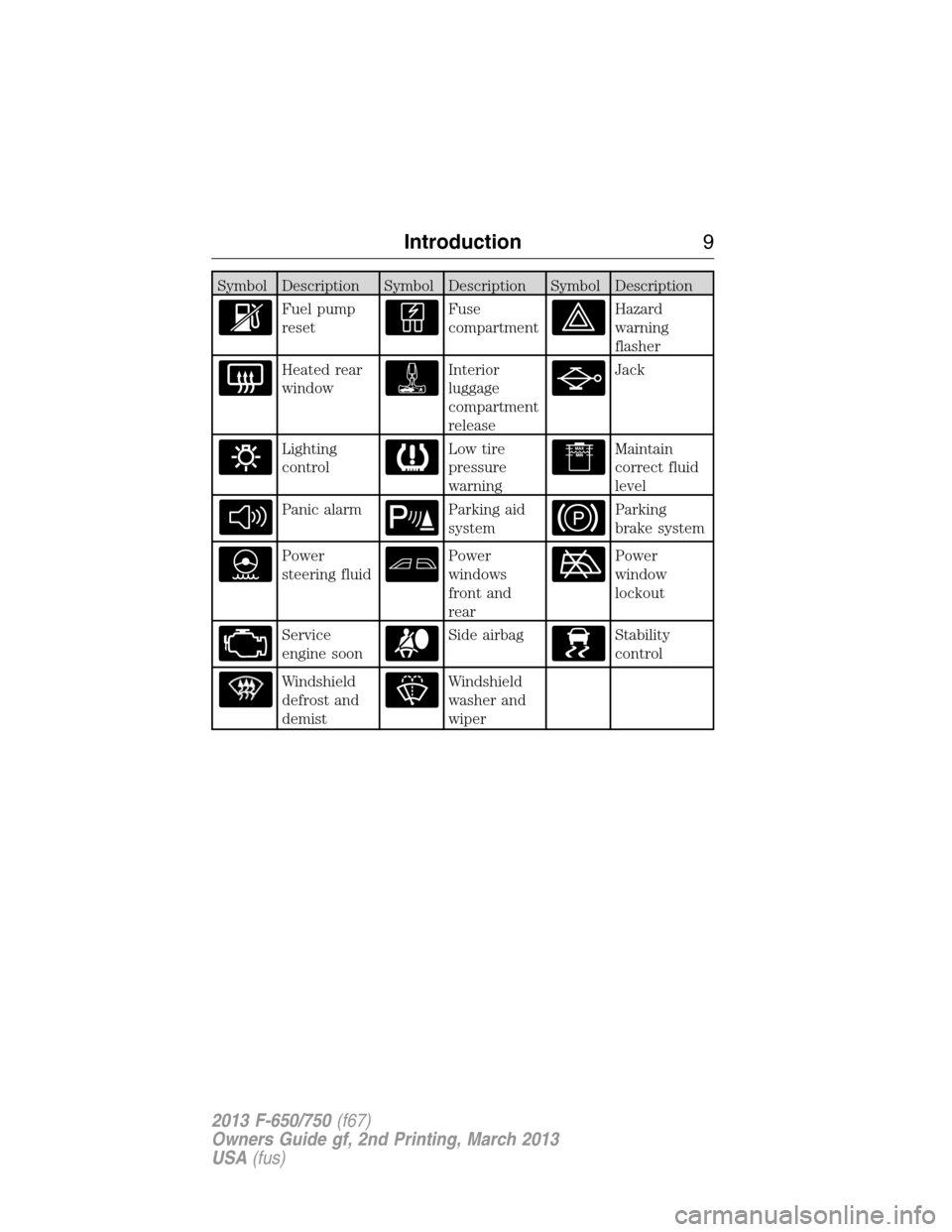
Symbol Description Symbol Description Symbol Description
Fuel pump
resetFuse
compartmentHazard
warning
flasher
Heated rear
windowInterior
luggage
compartment
releaseJack
Lighting
controlLow tire
pressure
warningMaintain
correct fluid
level
Panic alarmParking aid
systemParking
brake system
Power
steering fluidPower
windows
front and
rearPower
window
lockout
Service
engine soonSide airbagStability
control
Windshield
defrost and
demistWindshield
washer and
wiper
Introduction9
2013 F-650/750(f67)
Owners Guide gf, 2nd Printing, March 2013
USA(fus)
Page 65 of 378
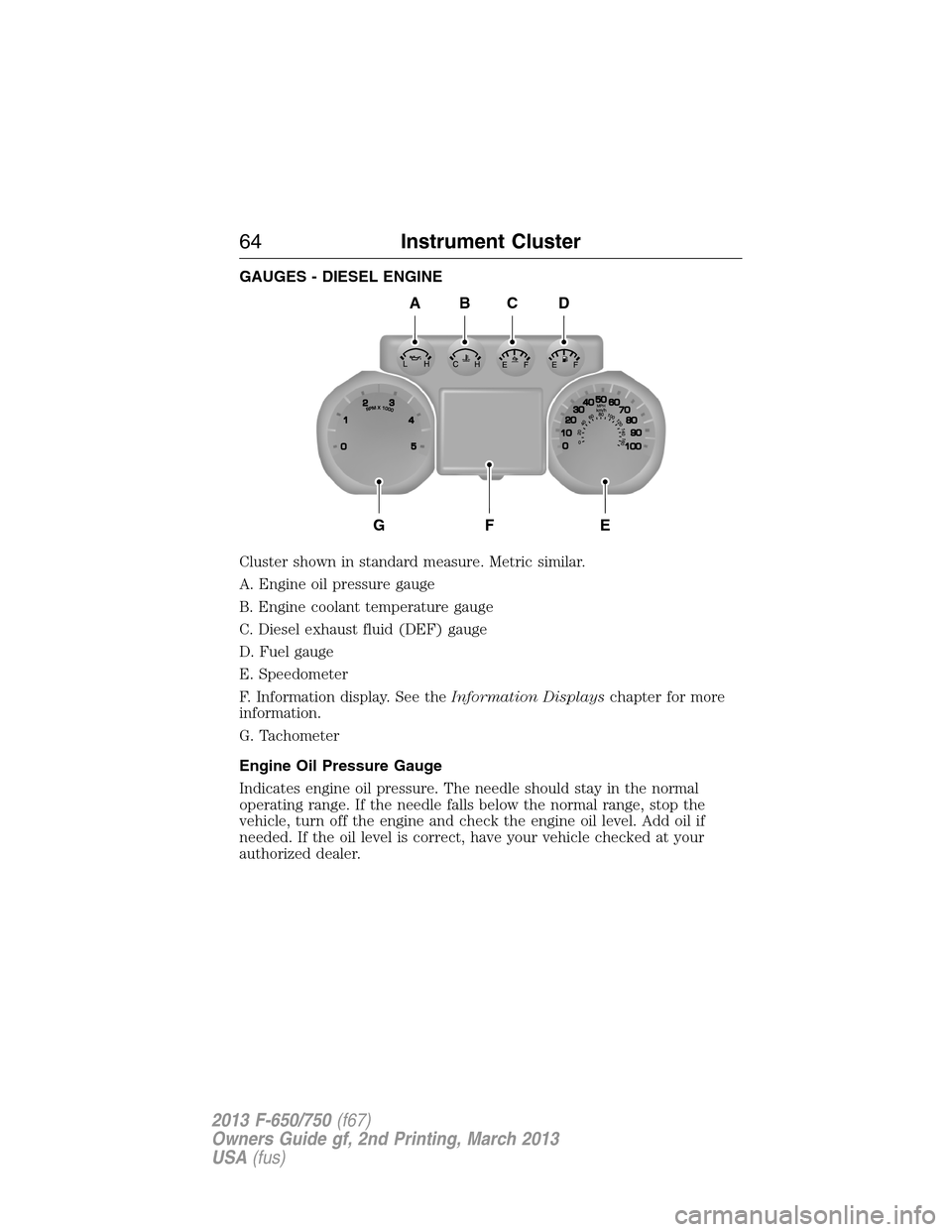
GAUGES - DIESEL ENGINE
Cluster shown in standard measure. Metric similar.
A. Engine oil pressure gauge
B. Engine coolant temperature gauge
C. Diesel exhaust fluid (DEF) gauge
D. Fuel gauge
E. Speedometer
F. Information display. See theInformation Displayschapter for more
information.
G. Tachometer
Engine Oil Pressure Gauge
Indicates engine oil pressure. The needle should stay in the normal
operating range. If the needle falls below the normal range, stop the
vehicle, turn off the engine and check the engine oil level. Add oil if
needed. If the oil level is correct, have your vehicle checked at your
authorized dealer.
A
GFE
BCD
64Instrument Cluster
2013 F-650/750(f67)
Owners Guide gf, 2nd Printing, March 2013
USA(fus)
Page 67 of 378
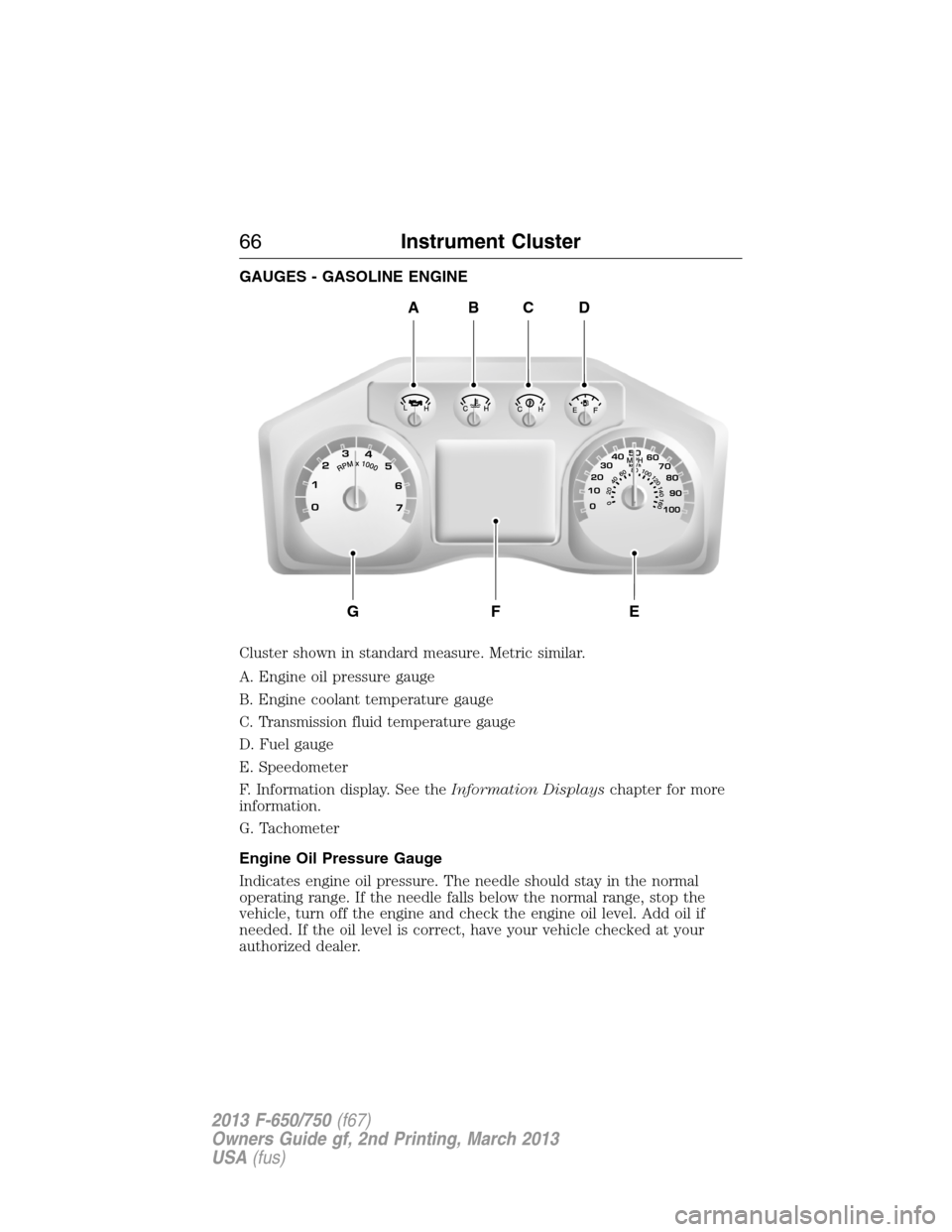
GAUGES - GASOLINE ENGINE
Cluster shown in standard measure. Metric similar.
A. Engine oil pressure gauge
B. Engine coolant temperature gauge
C. Transmission fluid temperature gauge
D. Fuel gauge
E. Speedometer
F. Information display. See theInformation Displayschapter for more
information.
G. Tachometer
Engine Oil Pressure Gauge
Indicates engine oil pressure. The needle should stay in the normal
operating range. If the needle falls below the normal range, stop the
vehicle, turn off the engine and check the engine oil level. Add oil if
needed. If the oil level is correct, have your vehicle checked at your
authorized dealer.
ABCD
GFE
66Instrument Cluster
2013 F-650/750(f67)
Owners Guide gf, 2nd Printing, March 2013
USA(fus)
Page 107 of 378
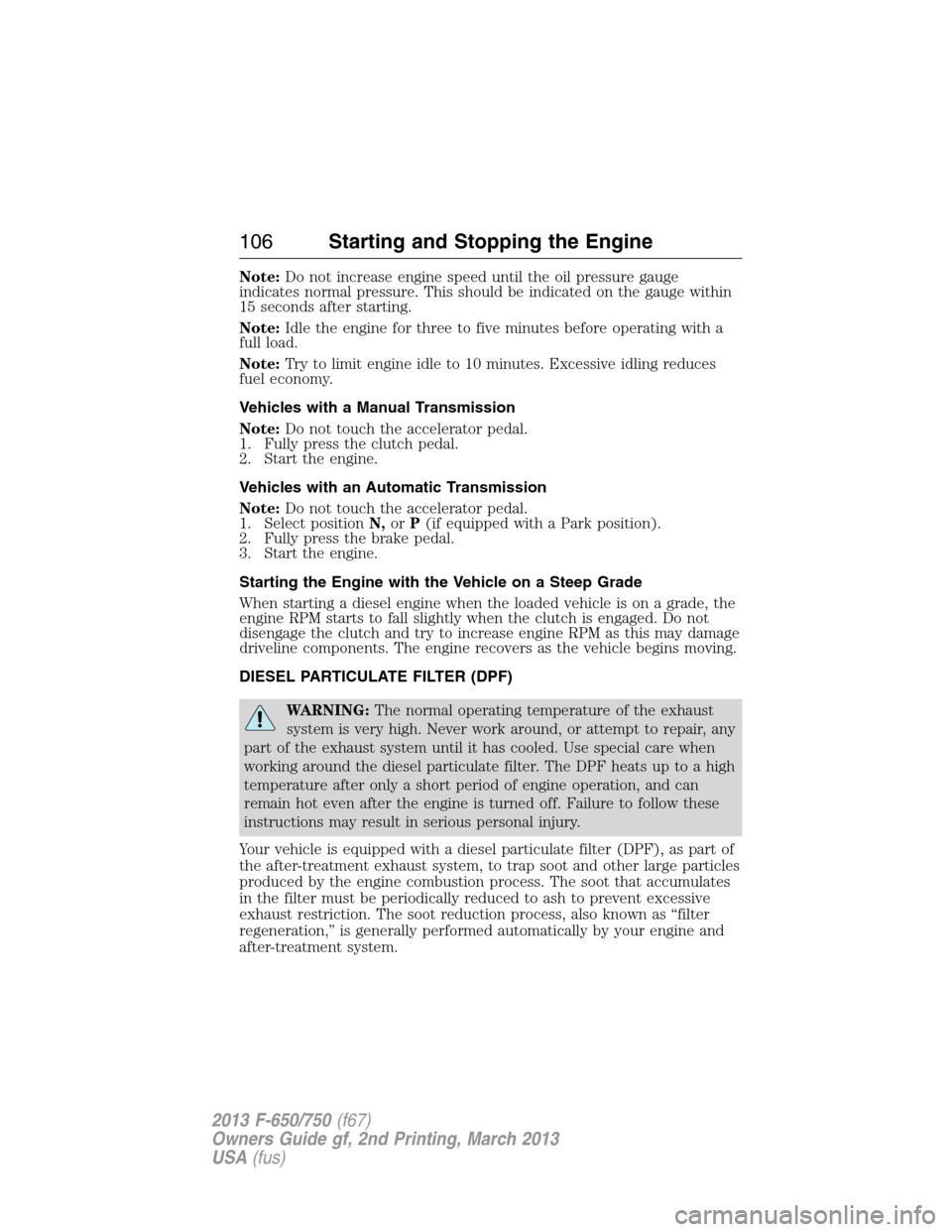
Note:Do not increase engine speed until the oil pressure gauge
indicates normal pressure. This should be indicated on the gauge within
15 seconds after starting.
Note:Idle the engine for three to five minutes before operating with a
full load.
Note:Try to limit engine idle to 10 minutes. Excessive idling reduces
fuel economy.
Vehicles with a Manual Transmission
Note:Do not touch the accelerator pedal.
1. Fully press the clutch pedal.
2. Start the engine.
Vehicles with an Automatic Transmission
Note:Do not touch the accelerator pedal.
1. Select positionN,orP(if equipped with a Park position).
2. Fully press the brake pedal.
3. Start the engine.
Starting the Engine with the Vehicle on a Steep Grade
When starting a diesel engine when the loaded vehicle is on a grade, the
engine RPM starts to fall slightly when the clutch is engaged. Do not
disengage the clutch and try to increase engine RPM as this may damage
driveline components. The engine recovers as the vehicle begins moving.
DIESEL PARTICULATE FILTER (DPF)
WARNING:The normal operating temperature of the exhaust
system is very high. Never work around, or attempt to repair, any
part of the exhaust system until it has cooled. Use special care when
working around the diesel particulate filter. The DPF heats up to a high
temperature after only a short period of engine operation, and can
remain hot even after the engine is turned off. Failure to follow these
instructions may result in serious personal injury.
Your vehicle is equipped with a diesel particulate filter (DPF), as part of
the after-treatment exhaust system, to trap soot and other large particles
produced by the engine combustion process. The soot that accumulates
in the filter must be periodically reduced to ash to prevent excessive
exhaust restriction. The soot reduction process, also known as “filter
regeneration,” is generally performed automatically by your engine and
after-treatment system.
106Starting and Stopping the Engine
2013 F-650/750(f67)
Owners Guide gf, 2nd Printing, March 2013
USA(fus)
Page 111 of 378
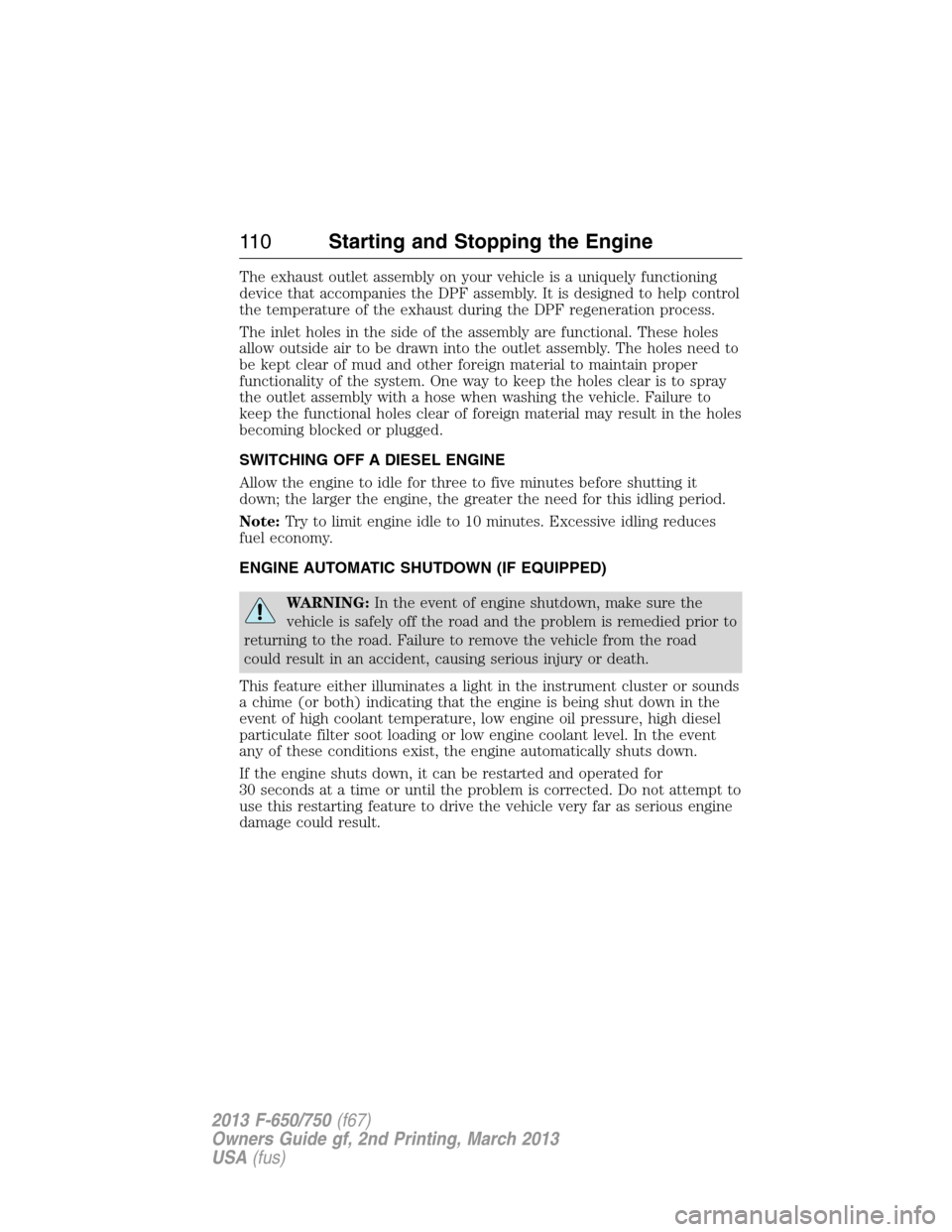
The exhaust outlet assembly on your vehicle is a uniquely functioning
device that accompanies the DPF assembly. It is designed to help control
the temperature of the exhaust during the DPF regeneration process.
The inlet holes in the side of the assembly are functional. These holes
allow outside air to be drawn into the outlet assembly. The holes need to
be kept clear of mud and other foreign material to maintain proper
functionality of the system. One way to keep the holes clear is to spray
the outlet assembly with a hose when washing the vehicle. Failure to
keep the functional holes clear of foreign material may result in the holes
becoming blocked or plugged.
SWITCHING OFF A DIESEL ENGINE
Allow the engine to idle for three to five minutes before shutting it
down; the larger the engine, the greater the need for this idling period.
Note:Try to limit engine idle to 10 minutes. Excessive idling reduces
fuel economy.
ENGINE AUTOMATIC SHUTDOWN (IF EQUIPPED)
WARNING:In the event of engine shutdown, make sure the
vehicle is safely off the road and the problem is remedied prior to
returning to the road. Failure to remove the vehicle from the road
could result in an accident, causing serious injury or death.
This feature either illuminates a light in the instrument cluster or sounds
a chime (or both) indicating that the engine is being shut down in the
event of high coolant temperature, low engine oil pressure, high diesel
particulate filter soot loading or low engine coolant level. In the event
any of these conditions exist, the engine automatically shuts down.
If the engine shuts down, it can be restarted and operated for
30 seconds at a time or until the problem is corrected. Do not attempt to
use this restarting feature to drive the vehicle very far as serious engine
damage could result.
11 0Starting and Stopping the Engine
2013 F-650/750(f67)
Owners Guide gf, 2nd Printing, March 2013
USA(fus)
Page 114 of 378
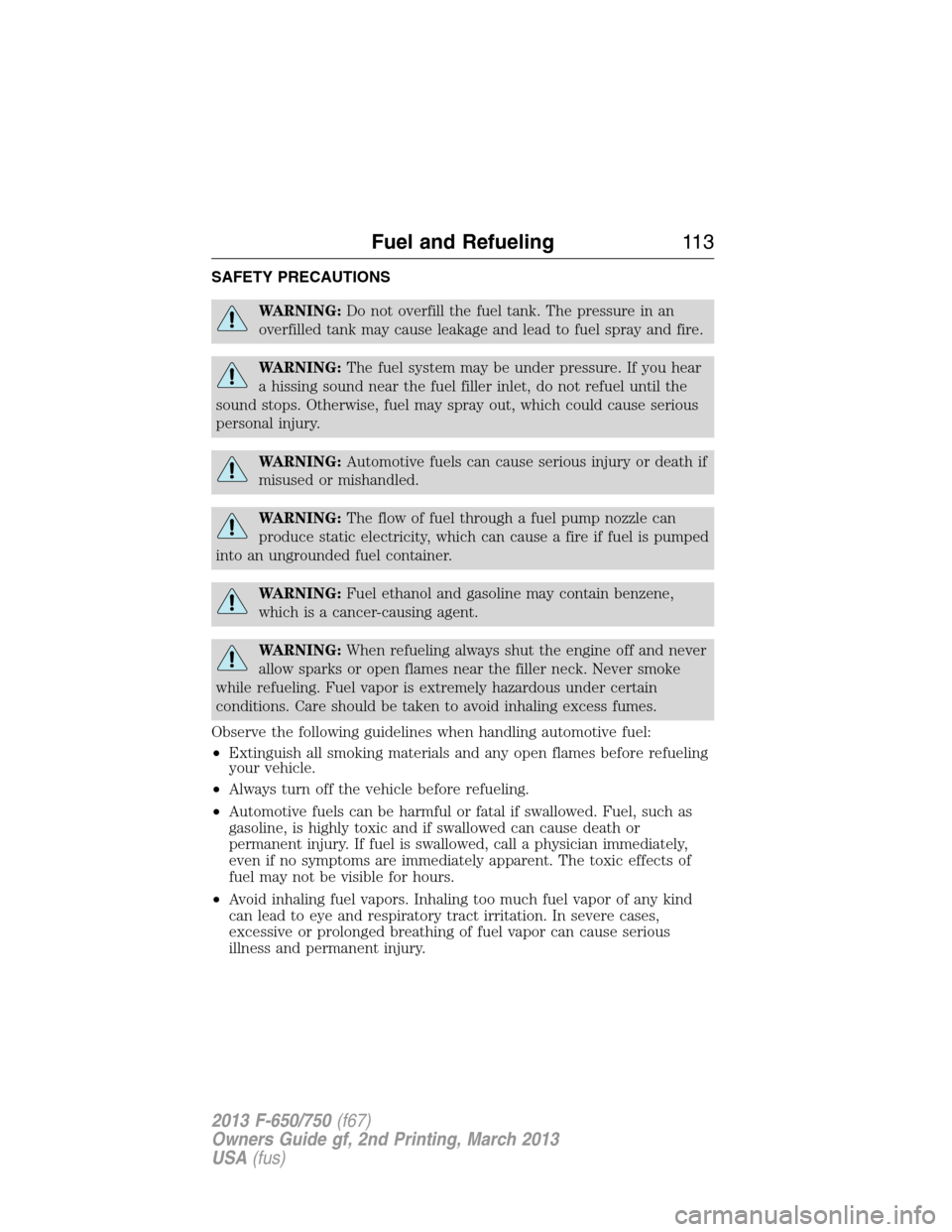
SAFETY PRECAUTIONS
WARNING:Do not overfill the fuel tank. The pressure in an
overfilled tank may cause leakage and lead to fuel spray and fire.
WARNING:The fuel system may be under pressure. If you hear
a hissing sound near the fuel filler inlet, do not refuel until the
sound stops. Otherwise, fuel may spray out, which could cause serious
personal injury.
WARNING:Automotive fuels can cause serious injury or death if
misused or mishandled.
WARNING:The flow of fuel through a fuel pump nozzle can
produce static electricity, which can cause a fire if fuel is pumped
into an ungrounded fuel container.
WARNING:Fuel ethanol and gasoline may contain benzene,
which is a cancer-causing agent.
WARNING:When refueling always shut the engine off and never
allow sparks or open flames near the filler neck. Never smoke
while refueling. Fuel vapor is extremely hazardous under certain
conditions. Care should be taken to avoid inhaling excess fumes.
Observe the following guidelines when handling automotive fuel:
•Extinguish all smoking materials and any open flames before refueling
your vehicle.
•Always turn off the vehicle before refueling.
•Automotive fuels can be harmful or fatal if swallowed. Fuel, such as
gasoline, is highly toxic and if swallowed can cause death or
permanent injury. If fuel is swallowed, call a physician immediately,
even if no symptoms are immediately apparent. The toxic effects of
fuel may not be visible for hours.
•Avoid inhaling fuel vapors. Inhaling too much fuel vapor of any kind
can lead to eye and respiratory tract irritation. In severe cases,
excessive or prolonged breathing of fuel vapor can cause serious
illness and permanent injury.
Fuel and Refueling11 3
2013 F-650/750(f67)
Owners Guide gf, 2nd Printing, March 2013
USA(fus)
Page 119 of 378
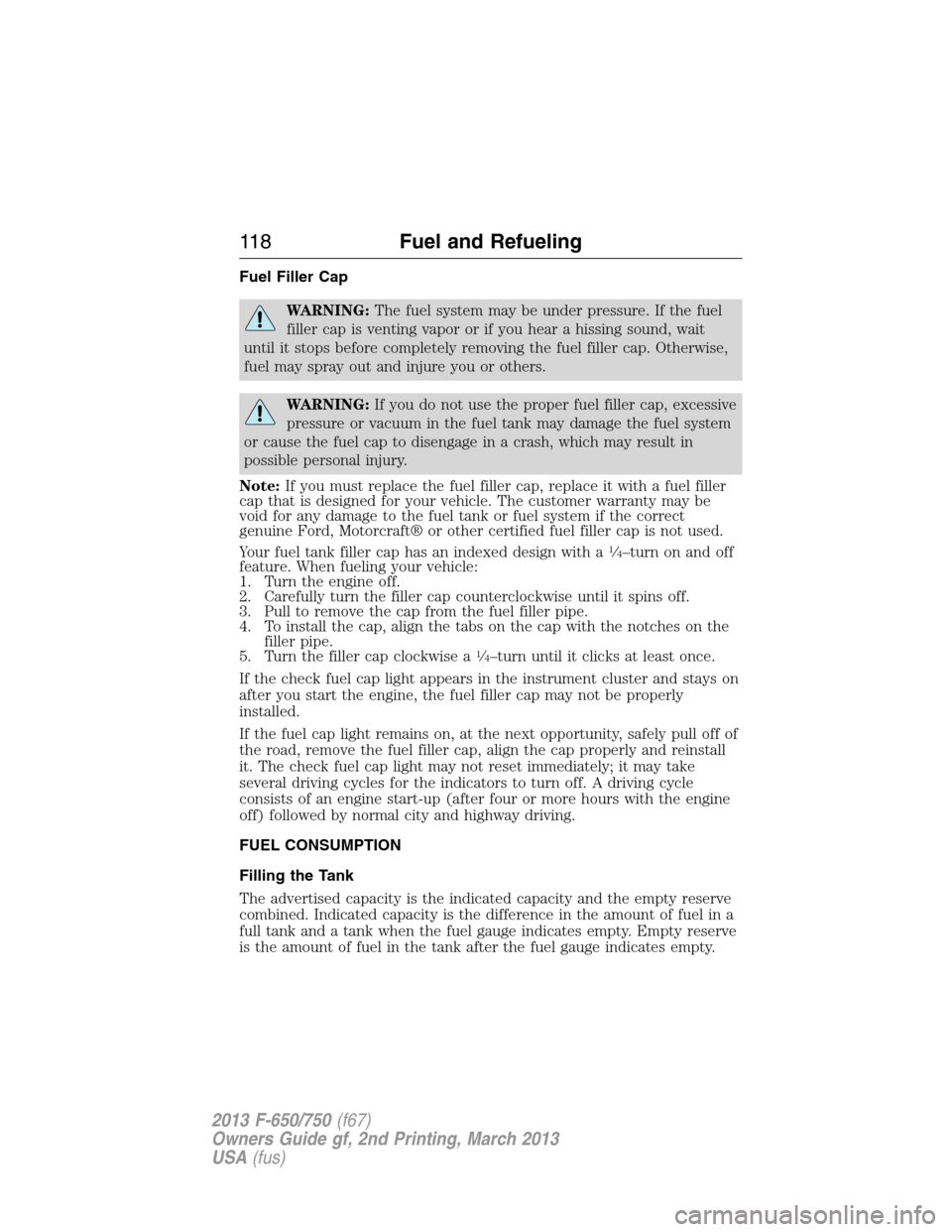
Fuel Filler Cap
WARNING:The fuel system may be under pressure. If the fuel
filler cap is venting vapor or if you hear a hissing sound, wait
until it stops before completely removing the fuel filler cap. Otherwise,
fuel may spray out and injure you or others.
WARNING:If you do not use the proper fuel filler cap, excessive
pressure or vacuum in the fuel tank may damage the fuel system
or cause the fuel cap to disengage in a crash, which may result in
possible personal injury.
Note:If you must replace the fuel filler cap, replace it with a fuel filler
cap that is designed for your vehicle. The customer warranty may be
void for any damage to the fuel tank or fuel system if the correct
genuine Ford, Motorcraft® or other certified fuel filler cap is not used.
Your fuel tank filler cap has an indexed design with a
1�4–turn on and off
feature. When fueling your vehicle:
1. Turn the engine off.
2. Carefully turn the filler cap counterclockwise until it spins off.
3. Pull to remove the cap from the fuel filler pipe.
4. To install the cap, align the tabs on the cap with the notches on the
filler pipe.
5. Turn the filler cap clockwise a
1�4–turn until it clicks at least once.
If the check fuel cap light appears in the instrument cluster and stays on
after you start the engine, the fuel filler cap may not be properly
installed.
If the fuel cap light remains on, at the next opportunity, safely pull off of
the road, remove the fuel filler cap, align the cap properly and reinstall
it. The check fuel cap light may not reset immediately; it may take
several driving cycles for the indicators to turn off. A driving cycle
consists of an engine start-up (after four or more hours with the engine
off) followed by normal city and highway driving.
FUEL CONSUMPTION
Filling the Tank
The advertised capacity is the indicated capacity and the empty reserve
combined. Indicated capacity is the difference in the amount of fuel in a
full tank and a tank when the fuel gauge indicates empty. Empty reserve
is the amount of fuel in the tank after the fuel gauge indicates empty.
11 8Fuel and Refueling
2013 F-650/750(f67)
Owners Guide gf, 2nd Printing, March 2013
USA(fus)
Page 122 of 378
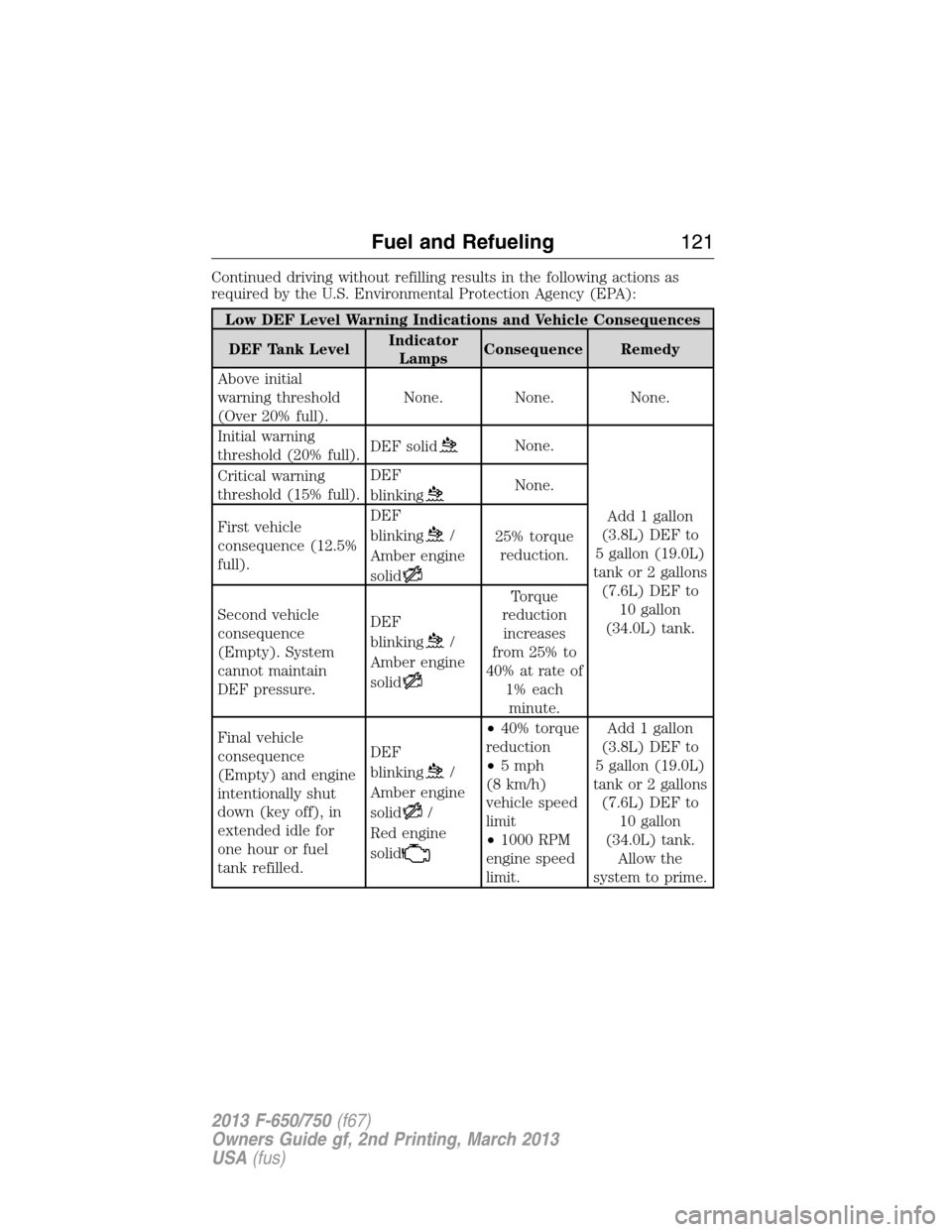
Continued driving without refilling results in the following actions as
required by the U.S. Environmental Protection Agency (EPA):
Low DEF Level Warning Indications and Vehicle Consequences
DEF Tank LevelIndicator
LampsConsequence Remedy
Above initial
warning threshold
(Over 20% full).None. None. None.
Initial warning
threshold (20% full).DEF solid
None.
Add 1 gallon
(3.8L) DEF to
5 gallon (19.0L)
tank or 2 gallons
(7.6L) DEF to
10 gallon
(34.0L) tank. Critical warning
threshold (15% full).DEF
blinking
None.
First vehicle
consequence (12.5%
full).DEF
blinking
/
Amber engine
solid25% torque
reduction.
Second vehicle
consequence
(Empty). System
cannot maintain
DEF pressure.DEF
blinking
/
Amber engine
solid
Torque
reduction
increases
from 25% to
40% at rate of
1% each
minute.
Final vehicle
consequence
(Empty) and engine
intentionally shut
down (key off), in
extended idle for
one hour or fuel
tank refilled.DEF
blinking
/
Amber engine
solid
/
Red engine
solid
•40% torque
reduction
•5 mph
(8 km/h)
vehicle speed
limit
•1000 RPM
engine speed
limit.Add 1 gallon
(3.8L) DEF to
5 gallon (19.0L)
tank or 2 gallons
(7.6L) DEF to
10 gallon
(34.0L) tank.
Allow the
system to prime.
Fuel and Refueling121
2013 F-650/750(f67)
Owners Guide gf, 2nd Printing, March 2013
USA(fus)
Page 123 of 378

Low DEF Level Warning Indications and Vehicle Consequences
for Emergency Vehicles
DEF Tank LevelIndicator
LampsConsequence Remedy
Above initial
warning threshold
(Over 25% full).None. None. None.
Below initial warning
threshold (25% full).DEF solid
None.
Add 1 gallon
(3.8L) DEF to
5 gallon (19.0L)
tank or 2 gallons
(7.6L) DEF to
10 gallon
(34.0L) tank. Critical warning
threshold (20% full).DEF
blinking
None.
First vehicle
consequence (15%
full).DEF
blinking
/
Amber engine
solid
Vehicle speed
limited to
55 mph
(88 km/h).
*
Final vehicle
consequence
(Empty) and engine
intentionally shut
down (key off) or in
extended idle for
one hour.DEF
blinking
/
Amber engine
solid
/
Red engine
solid
Vehicle speed
limited to
25 mph
(40 km/h).
**
Add 1 gallon
(3.8L) DEF to
5 gallon (19.0L)
tank or 2 gallons
(7.6L) DEF to
10 gallon
(34.0L) tank.
Allow the
system to prime.
*The vehicle speed restriction is suspended during pump operation when
using any of the following engine control modes:
•Power take-off
•Remote power take-off
•Remote throttle
•SAE J1939–commanded pressure governor.
**Those installations using a transmission tailshaft-driven power take-off
or pump during a stationary operation are also limited to 25 mph
(40 km/h) equivalent tailshaft speed during a final vehicle consequence.
122Fuel and Refueling
2013 F-650/750(f67)
Owners Guide gf, 2nd Printing, March 2013
USA(fus)
Page 125 of 378
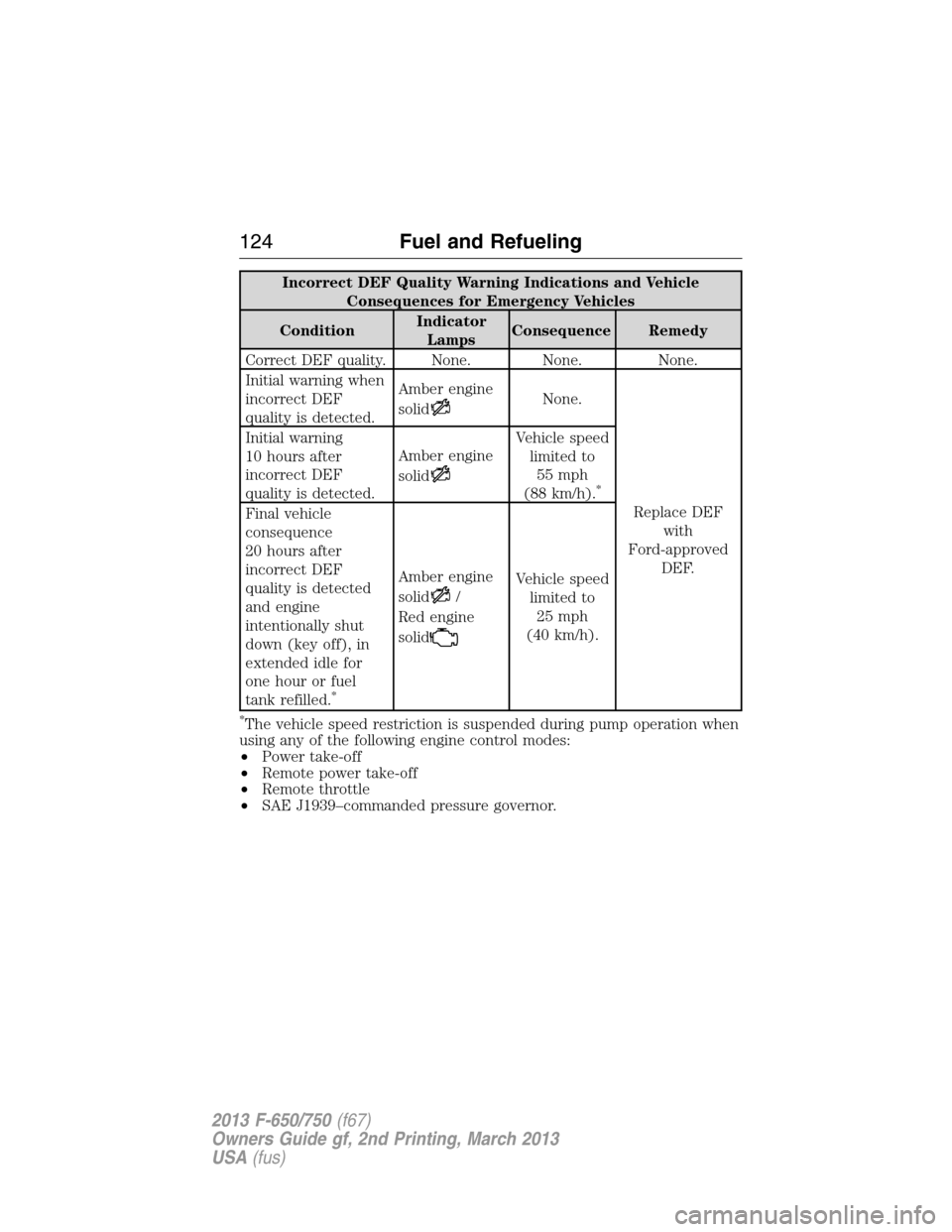
Incorrect DEF Quality Warning Indications and Vehicle
Consequences for Emergency Vehicles
ConditionIndicator
LampsConsequence Remedy
Correct DEF quality. None. None. None.
Initial warning when
incorrect DEF
quality is detected.Amber engine
solid
None.
Replace DEF
with
Ford-approved
DEF. Initial warning
10 hours after
incorrect DEF
quality is detected.Amber engine
solid
Vehicle speed
limited to
55 mph
(88 km/h).
*
Final vehicle
consequence
20 hours after
incorrect DEF
quality is detected
and engine
intentionally shut
down (key off), in
extended idle for
one hour or fuel
tank refilled.
*
Amber engine
solid
/
Red engine
solid
Vehicle speed
limited to
25 mph
(40 km/h).
*The vehicle speed restriction is suspended during pump operation when
using any of the following engine control modes:
•Power take-off
•Remote power take-off
•Remote throttle
•SAE J1939–commanded pressure governor.
124Fuel and Refueling
2013 F-650/750(f67)
Owners Guide gf, 2nd Printing, March 2013
USA(fus)